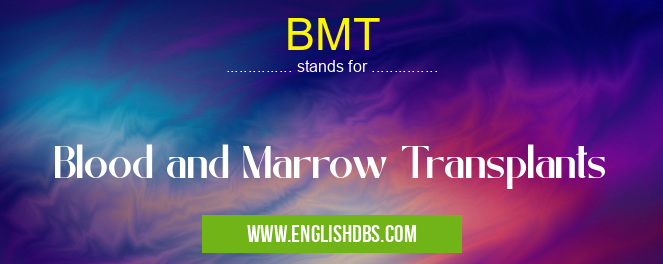What does BMT mean in TRANSPLANTATION
Blood and Marrow Transplants (BMT) are medical procedures that involve replacing diseased or damaged blood-forming cells with healthy ones. These procedures are used to treat a wide range of conditions, including blood cancers such as leukemia and lymphoma, as well as genetic disorders like sickle cell anemia and severe combined immunodeficiency.

BMT meaning in Transplantation in Medical
BMT mostly used in an acronym Transplantation in Category Medical that means Blood and Marrow Transplants
Shorthand: BMT,
Full Form: Blood and Marrow Transplants
For more information of "Blood and Marrow Transplants", see the section below.
Introduction: Blood and Marrow Transplants (BMT)
Meaning of BMT
The abbreviation BMT stands for Blood and Marrow Transplants. It refers to the process of replacing diseased or damaged blood-forming cells (bone marrow) with healthy ones from a donor.
Full Form of BMT
- B: Blood
- M: Marrow
- T: Transplants
What Does BMT Stand For?
BMT stands for Blood and Marrow Transplants, a medical procedure that involves replacing damaged or diseased blood-forming cells with healthy ones. This is typically done to treat certain types of cancer and blood disorders.
Types of BMT
There are two main types of BMT:
- Autologous BMT: In this type of transplant, the patient's own blood-forming cells are harvested, treated, and then returned to the patient's body.
- Allogeneic BMT: In this type of transplant, blood-forming cells are taken from a healthy donor and transplanted into the patient's body.
Essential Questions and Answers on Blood and Marrow Transplants in "MEDICAL»TRANSPLANTATION"
What is a blood and marrow transplant (BMT)?
A blood and marrow transplant (BMT) is a medical procedure that replaces damaged or diseased blood-forming cells with healthy ones. It is used to treat a variety of blood cancers and disorders.
Who needs a BMT?
BMT is typically used to treat people with blood cancers such as leukemia, lymphoma, and multiple myeloma. It can also be used to treat other conditions that affect the blood and bone marrow, such as sickle cell disease and aplastic anemia.
What are the different types of BMT?
There are two main types of BMT: autologous and allogeneic. Autologous BMT uses stem cells from the patient's own body, while allogeneic BMT uses stem cells from a donor.
What are the risks of BMT?
BMT is a complex procedure with potential risks. These risks include: infection, bleeding, graft-versus-host disease (GVHD), and death.
What is the success rate of BMT?
The success rate of BMT depends on the type of cancer being treated, the patient's age and overall health, and the type of transplant performed. Overall, the success rate for BMT is about 50%.
What is the recovery process like after BMT?
The recovery process after BMT can be long and challenging. Patients typically stay in the hospital for several weeks after the transplant. They may experience side effects such as fatigue, nausea, and vomiting. It can take several months or even years to fully recover from BMT.
What are the long-term side effects of BMT?
Some patients may experience long-term side effects from BMT, such as GVHD, infertility, and thyroid problems. These side effects can be managed with medication and lifestyle changes.
Final Words: BMT is a complex and potentially life-saving medical procedure. It is important to discuss the risks and benefits of BMT with your doctor to determine if it is the right treatment option for you.
BMT also stands for: |
|
| All stands for BMT |
